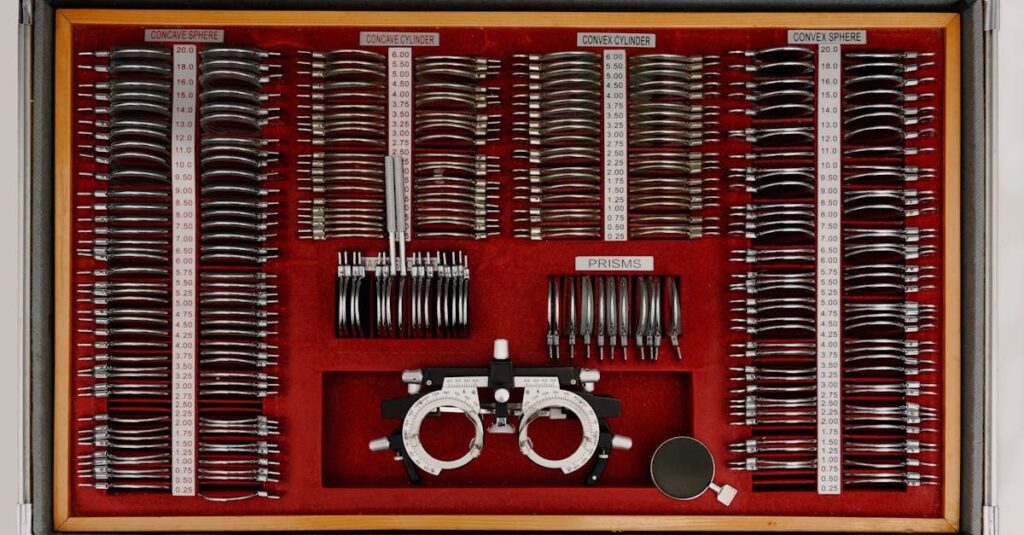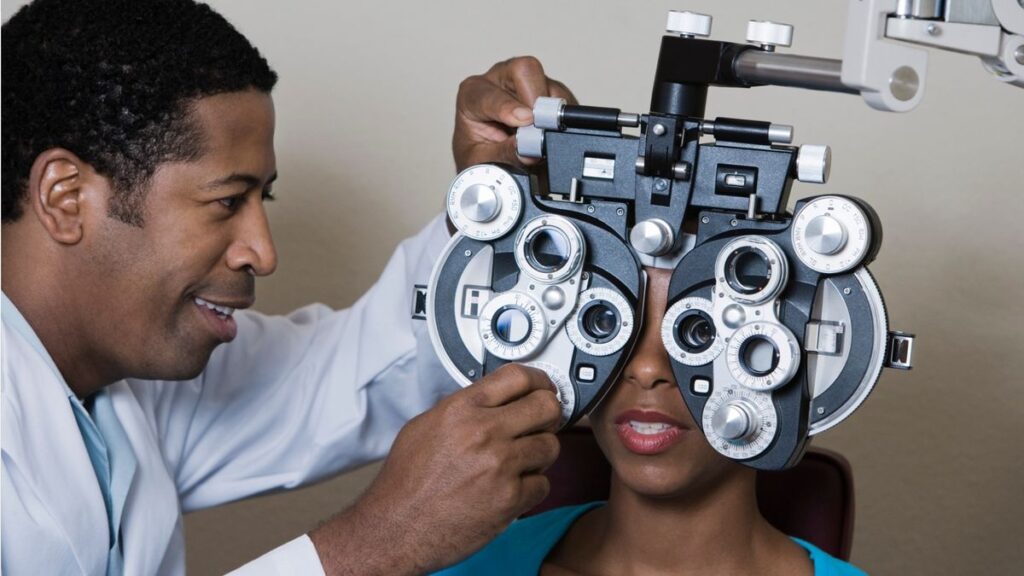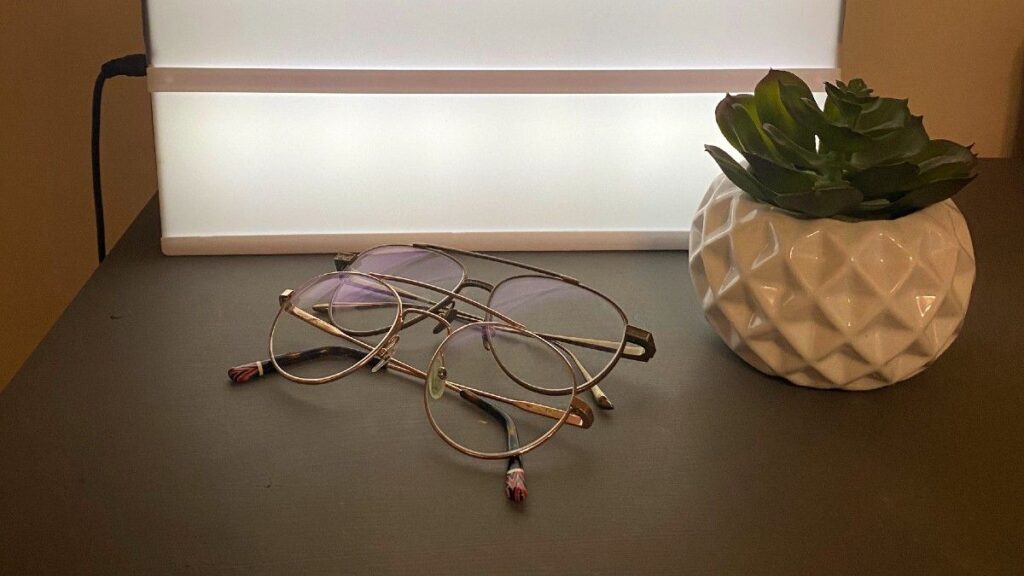Selecting the perfect pair of prescription eyeglasses isn’t just about clear vision; it’s about comfort, style, and ensuring your glasses fit like a glove. From understanding your prescription to choosing frames that flatter your face, this guide will walk you through a step-by-step process to achieve the perfect eyeglasses fitting. We’ll dive into the importance of professional adjustments and the role of personal style, so you can not only see your best but also look and feel great.
Key Takeaways
- Understanding your prescription and the significance of pupillary distance is crucial for optimal vision through your glasses.
- The perfect frame fit involves considering face shape, frame width, nose fit, and unique facial features for both aesthetics and comfort.
- Lens selection should balance personal style with functionality, considering material, technology, and your specific vision needs.
- Regular professional fitting and adjustments are essential to maintain the alignment of the optical centres with your pupils for the best visual experience.
- Building a relationship with a trusted optical store can provide personalized service, ensuring ongoing comfort and maintenance of your glasses.
Understanding Your Vision Needs and Prescription

Interpreting Your Eye Exam Results
After your eye exam, you’ll receive a prescription that might look like a confusing mix of numbers and letters. Understanding this prescription is crucial for getting eyeglasses that correct your vision effectively. The prescription typically includes values for sphere (SPH), cylinder (CYL), and axis, which indicate the power of the lenses needed to correct your vision.
Here’s a simple breakdown of what these terms mean:
- SPH (Sphere): Indicates the lens power, measured in diopters (D), required to correct nearsightedness or farsightedness.
- CYL (Cylinder): Reflects the amount of lens power for astigmatism. If this column is blank, you likely don’t have astigmatism.
- Axis: A number between 0 and 180 degrees that defines the orientation of astigmatism correction.
Remember, accurate interpretation of your prescription ensures that your glasses will help you see as clearly as possible.
It’s also important to note your pupillary distance (PD), which is the distance between the centers of your pupils. This measurement is essential for aligning the optical center of the lenses with your eyes. While some eye care professionals readily provide this, others may not, especially if they are affiliated with a retail store. If your PD is not included in your prescription, ask your eye care provider or measure it yourself with careful instructions.
The Importance of Accurate Measurements
When selecting the perfect pair of prescription eyeglasses, accurate frame measurement and pupillary distance are crucial for ensuring that the lenses align properly with your eyes. This alignment is essential for comfortable and clear vision, especially when choosing eyewear online, where convenience and support are key to a seamless shopping experience.
Accurate measurements are the foundation of a well-fitting pair of glasses. They prevent the misalignment of the optical centre, which can cause discomfort and visual distortion.
To achieve this, you will need a pupillary distance ruler. The process involves measuring the binocular pupillary distance—the space between the centres of the two pupils—or the monocular pupillary distance for each eye, which is the distance from the centre of the pupil to the centre of the nose. These measurements are critical, particularly for those with progressive lenses or complex prescriptions, as they ensure the optical centre of the lenses matches the visual axis.
Here’s a simple guide to the measurements needed:
- Binocular PD: Measure the distance between the pupils in millimetres.
- Monocular PD: Measure from the pupil to the centre of the nose for each eye.
Remember, if the pupillary distance is measured incorrectly, the only solution is to re-measure and remake the spectacles. This is why it’s important to consult with an independent ophthalmologist for the most precise measurement, especially for those with more complicated vision needs.
Recognizing the Significance of Pupillary Distance
Pupillary distance (PD) is a critical measurement for ensuring that your eyeglasses fit properly and your vision is optimally corrected. PD refers to the distance between the centers of your pupils, and it is essential for aligning the optical center of the lenses with your line of sight. Incorrect PD can lead to discomfort, eye strain, or even blurred vision.
Accurate PD measurement is particularly important for those with high prescriptions or progressive lenses, as even slight deviations can impact vision quality.
When selecting eyewear, especially online, it’s important to have an accurate PD measurement. Many online retailers now provide innovative tools to help you measure your PD at home. These tools can guide you through the process, ensuring that you can master online eyewear fitting with precision.
Here’s a simple guide to understanding when to measure monocular and binocular PD:
- Monocular PD is measured when there is a high prescription, significant facial asymmetry, or for bifocal/progressive lens wearers.
- Binocular PD is usually sufficient for those with a low prescription and minimal facial asymmetry, and it’s often the default measurement for babies and young children.
Ensuring that your PD is measured correctly is a step that cannot be overlooked for the perfect eyeglass fit.
Selecting the Right Frame for Your Face Shape

Assessing Frame Width and Nose Fit
Selecting the perfect eyeglasses requires attention to detail, especially when it comes to frame width and nose fit. The frame width should match the width of your face to ensure a comfortable fit without any pinching or sliding. The lens width, a key component of frame width, is measured from the bridge of your nose to your temple. It’s important to take two separate measurements for the left and right sides, as they can sometimes differ, although they are often the same.
When assessing nose fit, consider the bridge size and shape. A well-fitting bridge will prevent your glasses from slipping and reduce pressure on your nose.
To help you find your ideal size, many brands provide standard measurements for lens width, bridge, and arm length. For instance, MOSCOT categorizes frame sizes into narrow, average, and wide, with specific lens width ranges:
- Narrow: 42mm – 45mm
- Average: 46mm – 49mm
- Wide: 50mm and above
Remember, these are general guidelines, and personal comfort should always take precedence. If you’re unsure, opt for an average size or seek professional assistance for a tailored fit.
Choosing Frames for Different Face Shapes
Selecting the perfect frame for your eyeglasses involves understanding how different styles complement various face shapes. Round faces benefit from angular frames that add definition, while square faces are softened by rounder frames. Oval faces are versatile, often looking great in most frame styles, but especially those that are as wide as the broadest part of the face. Heart-shaped faces can aim for frames that balance the width of their forehead with their narrower chin.
For those with unique features, such as a particularly narrow or wide head, frame size is crucial. Here’s a quick guide to help you start:
- Narrow: Opt for frame sizes between 42mm – 45mm.
- Average: Most people fit comfortably in this range. When in doubt, go average.
- Wide: Choose frames that are slightly larger if hats tend to feel snug.
- Extra Wide: Look for sizes that provide additional room if your head is especially wide.
Remember, the key to a flattering fit is not just face shape but also personal style and comfort. Our fit specialists are always ready to assist you in finding frames that not only fit well but also reflect your personality and style preferences.
Adjusting for Unique Features and Comfort
When selecting eyeglasses, it’s crucial to consider not just the style and prescription needs, but also the unique features of your face and the comfort level of the frames. Comfort is paramount, as it affects both how often you’ll wear your glasses and how they make you feel. An uncomfortable pair can lead to physical discomfort and a lack of confidence, detracting from your daily activities.
Advanced fabrication techniques and clinical insights drive personalized lens design. Frame selection balances prescription power with face shape and design for optimal vision and aesthetics.
Here are some factors to consider for a personalized fit:
- The material of the frame, which can affect weight and texture against the skin.
- The color and design, which contribute to the overall aesthetic and how you feel wearing the glasses.
- The bridge fit and temple length, ensuring the glasses sit comfortably without slipping.
Building a rapport with a local optical store can be beneficial for personalized fittings and recommendations. Remember, the goal is to find eyewear that suits your individual preferences and provides a comfortable fit, enhancing both your vision and your personal style.
Lens Selection and Customization Options

Exploring Lens Materials and Technologies
When selecting eyeglasses, the material of the lenses is as crucial as the prescription itself. Common eyeglass lens materials include standard glass, standard plastic, polycarbonate, Trivex, and high-index materials, each offering unique benefits. For instance, polycarbonate lenses are known for their impact resistance, making them ideal for sports or children’s eyewear.
Recent advancements in lens technology have introduced features that cater to modern needs. Digital lenses can help reduce eye fatigue, and some come with protection against blue light from screens. Coatings such as anti-reflective and blue light-blocking can enhance vision while protecting the eyes from harmful emissions.
It’s essential to consider both the material and the technology of the lenses to ensure optimal visual clarity and comfort.
For those with specific lifestyle needs, customized progressive lenses can be tailored to your daily activities, whether for work or hobbies. Always consult with your optician to understand the best options for your individual vision requirements.
Understanding Progressive Lens Compatibility
Progressive lenses offer a seamless transition between different viewing distances, but compatibility with your vision needs is crucial. Vision clarity across all zones—distance, intermediate, and near—is essential. You should experience no strain or blurriness at any range. Recent advancements in digital lens technology have introduced features that reduce eye fatigue and protect against blue light, making them a personalized choice for work and leisure activities.
When considering progressive lenses, it’s important to understand that not all frames are suitable. Highly curved lenses can present optical challenges, and certain prescriptions may be limited by the lens curvature. For prescriptions stronger than +/- 4.00, manufacturers often avoid progressive lenses to prevent distortion.
Progressive lenses require precise measurements, especially for pupillary distance, which can vary for distance and close-up vision. An accurate PD ensures the optical centre of the lens aligns with your eyes, providing optimal vision and comfort.
If you’re contemplating progressive lenses, consult with an optician who can guide you through the selection process and ensure the segment height is set correctly. This may involve trying on a sample frame and submitting a photo to fine-tune the fit.
Personal Style and Lens Functionality
When selecting eyeglasses, the intersection of personal style and lens functionality cannot be overstated. Your eyewear is a reflection of your personality, and it’s essential to find frames that resonate with your individuality. Whether you’re drawn to classic elegance, modern minimalism, or eclectic designs, there’s a frame to match every aesthetic preference.
- Classic sophistication: Timeless designs that never go out of style
- Bold statement pieces: Eyewear that stands out and makes an impact
- Quirky, offbeat designs: Unique frames that showcase your creative side
Beyond aesthetics, practicality plays a crucial role in your selection. Consider your daily activities and choose glasses that can keep up with your lifestyle. For those in front of screens or on the move, durability, flexibility, and lens coatings are key factors. Brands today offer a harmonious blend of style and functionality, ensuring that you don’t have to compromise on either.
Remember, custom eyewear offers personalized frame design and lens fitting for optimal vision and comfort. This guide decodes prescriptions and advises on selecting frames and lenses for style and clarity.
The Role of Professional Fitting and Adjustment

The Necessity of Expert Frame Adjustment
While it’s possible to make minor adjustments to your glasses at home, such as tweaking the temples or tightening screws, these are merely temporary fixes. Professional frame adjustment is crucial to ensure that your glasses fit perfectly and provide the best vision possible. An expert optician will make precise adjustments that account for your unique facial features and the specific requirements of your prescription.
- A pupillary distance ruler
- Knowledge of the frame’s structure
- Understanding of the wearer’s facial anatomy
Ensuring that the optical centres are correctly aligned with your pupils is essential for clear vision. This can only be achieved through meticulous professional adjustment.
Regular visits to an optician for frame adjustments are not just about comfort; they are about maintaining the correct alignment of the optical centres with your pupils. This is vital for optimal vision and to prevent issues such as eye strain or headaches.
Maintaining Optical Centre Alignment
Ensuring the optical centre of your eyeglasses aligns with your pupils is paramount for clear vision. Incorrect alignment can lead to eye strain and headaches, as light rays are improperly refracted. To maintain this crucial alignment, follow these steps:
- Accurately measure the pupillary distance to establish a baseline for alignment.
- Use a focimeter or hand neutralisation to locate the optical centre of the lens.
- For consistency, start with the right lens and then adjust the left.
- Secure the spectacles and mark the optical centre for reference during adjustments.
It is therefore crucial for the optical centre to be correctly aligned with the wearer’s pupils, so they can see clearly, no matter which direction they look in.
Remember, adjustments to the optical centre should be done with precision. A small screwdriver may be required to fix glasses that are sliding down your nose, ensuring the lenses remain secure within the frames.
When to Seek Re-adjustment for Optimal Fit
Even the best-fitted eyeglasses may require re-adjustment over time. Daily wear and tear, changes in facial structure, or new prescriptions can alter the fit of your glasses. It’s crucial to recognize the signs that indicate the need for a professional fitting. Here are some scenarios when you should consider seeking re-adjustment:
- Your glasses frequently slip off your nose or pinch behind your ears.
- You experience discomfort, red marks, or headaches after prolonged wear.
- The lenses seem misaligned with your line of sight, affecting your vision.
- You’ve received a new prescription that may affect the frame’s alignment.
Regular visits to a trusted optical store ensure that your glasses are always perfectly aligned with your vision needs. Building a relationship with your optician allows for timely adjustments, essential for maintaining optimal comfort and functionality.
Remember, a well-adjusted pair of glasses should feel comfortable throughout the day and provide clear, unobstructed vision. If you notice any changes in how your glasses fit or function, don’t hesitate to contact your optician for a professional assessment.
The importance of professional fitting and adjustment in eyewear cannot be overstated. Properly fitted glasses or contact lenses not only ensure maximum comfort but also safeguard your vision health. At OPTIGRID, we specialize in providing personalized fitting services that cater to your unique needs. Don’t compromise on the quality of your vision. Visit our website to schedule an appointment with our expert opticians and experience the difference a professional fitting can make.
Conclusion
In conclusion, finding the perfect prescription eyeglasses is a blend of science and personal style. It’s essential to prioritize fit over fashion, ensuring that the glasses not only look good but also provide the correct optical alignment for your vision needs. Remember to consider frame width, nose fit, temple length, and how the glasses complement your face shape. Regular visits to a trusted optical store can help with adjustments, maintenance, and personalized recommendations. Whether you choose to shop online or offline, always ensure that your prescriptions and measurements are up to date. Investing in high-quality glasses is not just about aesthetics; it’s about comfort, durability, and, most importantly, the health of your eyes. By following the steps outlined in this guide, you can achieve a perfect fit that enhances your look and supports your vision.
Frequently Asked Questions
How can I ensure my eyeglasses fit properly?
To ensure a proper fit, select frames that match your face shape and size, and have a professional optician adjust the temples, nose pads, and frame width. Regular adjustments can maintain the correct alignment of the optical centers with your pupils.
Why is pupillary distance important in eyeglasses fitting?
Pupillary distance (PD) is crucial because it ensures that the optical centers of the lenses are aligned with your pupils, providing optimal vision and reducing strain. Accurate PD measurements are essential for the effectiveness of your prescription lenses.
Can I buy prescription glasses online with confidence?
Yes, you can buy prescription glasses online, but it’s recommended to try them on offline first for the right fit. Ensure you have an accurate prescription and measurements. Establishing a relationship with a trusted optical store can also help with fitting and maintenance.
What should I consider when choosing frames for different face shapes?
When choosing frames, consider the width and nose fit for comfort, select styles that complement your face shape (e.g., round frames for square faces), and account for unique features like long eyelashes or progressive lens compatibility.
How often should I have my eyeglasses adjusted?
You should have your eyeglasses adjusted whenever you feel discomfort or if the fit seems off. Regular visits to an optical store can ensure your glasses are well-maintained and adjustments are made as needed for optimal comfort and vision.
What are the benefits of investing in high-quality eyeglasses?
Investing in high-quality eyeglasses can enhance your look and comfort. Higher-grade glasses often provide better craftsmanship, durability, and a more precise fit, making them a valuable investment for both style and vision.

I am a seasoned software engineer with over two decades of experience and a deep-rooted background in the optical industry, thanks to a family business. Driven by a passion for developing impactful software solutions, I pride myself on being a dedicated problem solver who strives to transform challenges into opportunities for innovation.
